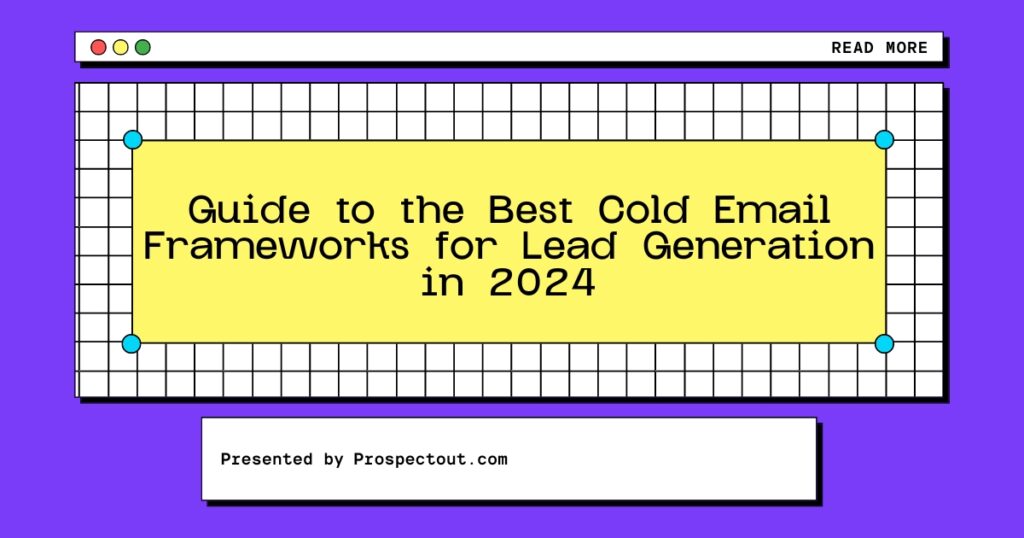Sending emails is one of the most effective ways to connect with people. With over 4 billion email users and more than 7 billion email accounts worldwide, email remains a powerful tool, especially in the business world.
Cold emails don’t always guarantee immediate results. You might not hear back from prospects, which can be frustrating. To improve your chances of getting responses, it’s important to keep a few key strategies in mind.

In this post, we’ll explore How to Write a Cold Email that Actually Works. But first, let’s quickly cover the basics before proceeding to the tips.
Table of Contents
What Makes a Cold Email Effective?
Your first conversation with a prospective customer, investor, or partner is through a cold email. If you make a mistake, your email will be immediately disposed of. The key to writing a successful cold email is to master a few essential elements:
- Subject Line: This is the most important part. 47% of recipients read emails based only on the subject line, making it the entry point to your messages.
For more detailed strategies, explore our guide on what makes a cold email effective.
- Opening Sentence: After the subject line, you need to grab their attention quickly. Don’t waste time introducing yourself. Instead, lead with value or insight that speaks to their pain point.
- Value Proposition: Why should they care? This is the time to offer something relevant and helpful. Personalization is key here. Show that you’ve done your homework.
To dive deeper into personalization, check out our post on cold email frameworks.
- Call to Action (CTA): How would you like them to proceed next? Don’t be aggressive, but be direct anyway. Guide them to a clear, actionable next step, whether it’s scheduling a meeting or answering a simple question.
- Follow-Up: Most cold emails get ignored the first time. A polite, well-timed follow-up can double your chances of getting a response.
For more on follow-up strategies, explore our cold email strategy guide.
5 Cold Email Writing Tips to Help You Get Responses
1. Personalize the Subject Line
A generic subject line is a surefire way to get ignored. Instead, make it specific to your recipient. Include their name, company, or even better—a pain point.
For example, instead of “Let’s Connect,” try “{{First Name}}, Struggling with Your Lead Generation?”
This shows you’ve put in some effort and instantly signals relevance.
2. Open with Value, Not an Introduction
The opening sentence should be all about the recipient, not you. Start by addressing their challenges or mentioning something you know about them.
For example, “I noticed you’ve been expanding your sales team and thought you might be dealing with scaling challenges.”
This immediately shows that you’ve done your homework and are here to help.
3. Show Empathy for Their Pain Points
Cold emails are more effective when you show empathy. Acknowledge their challenges before offering a solution.
For instance,
“Managing a growing team can be overwhelming, especially when budgets are tight. That’s why I thought our automation tools could save you time and resources.”
This builds connection and trust.
4. Craft a Clear Call to Action (CTA)
A vague CTA will leave your recipient unsure about what to do next. Be clear and specific.
Instead of “Let’s chat,” say, “Would you be available for a 15-minute call next Tuesday at 10 AM?”
Make it as easy as possible for them to respond. Short and simple works best here.
5. Follow-Up Thoughtfully
No response? Don’t take it personally—people are busy. Most responses come after the first or second follow-up. Politely remind them of the previous email and add a new value point.
“I wanted to circle back and share a recent case study that shows how we’ve helped companies like yours increase efficiency by 20%.”
This keeps the conversation fresh without sounding pushy.
Our cold email strategy guide offers more insights into creating effective follow-up plans.
How to Write a Cold Email That Actually Works
Cold emailing isn’t about blasting hundreds of impersonal emails. It’s about precision and relevance.
Here’s a simple structure that works:
- Subject Line: Personalized and specific. E.g., “{{First Name}}, Improve Your Lead Generation by 30% This Quarter.”
- Opening Sentence: Hook them in by addressing their pain point or complimenting their recent achievements. “I noticed you’ve expanded into three new markets recently—congrats! Scaling operations can be tricky…”
- Value Proposition: Give them a reason to read further. “Our platform helps teams like yours save 10 hours a week by automating tedious tasks.”
- Clear CTA: “Can we set up a 15-minute chat next Thursday to explore how we can support your team?”
- Polite Close: Thank them for their time. “Looking forward to hearing from you!”
If you follow this structure, your emails will stand out from the sea of generic pitches.
For more insights on creating effective cold emails, check out our full guide on the best cold email frameworks for 2024.
Examples of Effective Cold Emails That Get a Response
1. Sales Example:
Subject: “{{First Name}}, struggling to keep up with leads at {{Company}}?”
Body: “Hi {{First Name}}, I noticed that {{Company}} has been growing fast, especially in the past year. That’s awesome! But I’m guessing it might be tough keeping up with all the new leads. Our lead management software could save you hours each week. Would you be available for a quick call on Thursday at 10 AM to discuss how we can help?”
2. Networking Example:
Subject: “{{First Name}}, loved your recent post on scaling startups!”
Body: “Hi {{First Name}}, I came across your article on startup scaling strategies, and I loved your insights. I’ve been following your work for a while and would love to connect. I’m working on a similar project and would value your thoughts. Do you have time for a 10-minute call next week?”
If you’re in SaaS, manufacturing, finance, recruitment, or M&A then these expert tips will skyrocket your cold email response rates.
FAQ
What are the best practices for crafting a cold email subject line?
Use personalized, concise subject lines that highlight specific details or pain points. For example, “{{First Name}}, Quick Question About Your Recent Project” engages the recipient effectively.
How can I personalize my cold emails effectively?
Personalize emails by referencing relevant details about the recipient’s business or industry, such as recent achievements or challenges, to increase relevance and engagement.
What should be included in the opening sentence of a cold email?
Begin with a compelling hook that directly addresses the recipient’s needs or interests, avoiding lengthy introductions. Focus on how your email provides value.
How do I create a compelling value proposition in my cold email?
Clearly articulate how your offer solves a specific problem or provides significant benefits. Use precise data or examples to demonstrate the impact on the recipient’s business.
What’s the best way to follow up on a cold email?
Follow up with a polite reminder that references the previous email and offers additional value. Space follow-ups over a week or two to maintain engagement without being intrusive.
How can I measure the effectiveness of my cold email campaigns?
Track open rates, click-through rates, and response rates using analytics tools. These metrics provide insights into campaign performance and areas for improvement.
What are common mistakes to avoid when sending cold emails?
Avoid sending generic content, using aggressive sales tactics, and making errors. Ensure emails are personalized, targeted, and professionally written to make a positive impact.
How often should I send follow-up emails?
Send 2-3 follow-up emails spaced out over one to two weeks. Each follow-up should add new value or insights to keep the conversation relevant.
Can using templates help improve cold email responses?
Yes, templates streamline the process but should be customized for each recipient. Personalizing templates enhances relevance and effectiveness.
What tools can help optimize cold email campaigns?
Utilize email automation software, CRM systems, and analytics platforms to enhance personalization, track performance, and manage follow-ups efficiently.
Conclusion: Key Takeaways
Writing an effective cold email is about personalization, sympathy, and relevance. Focus on your recipient’s needs, create a clear CTA, and follow up thoughtfully; you can turn cold leads into warm opportunities.
Remember, not every email will work right away. Test different subject lines, openings, and CTAs. The more you refine your approach, the better your chances of success. Thanks for reading, and happy emailing!



